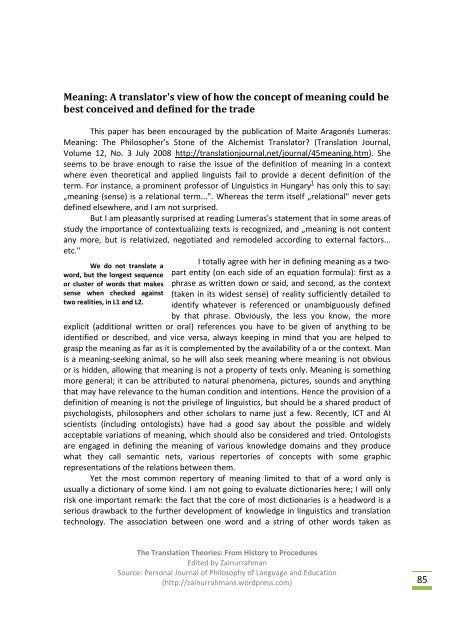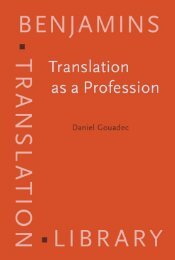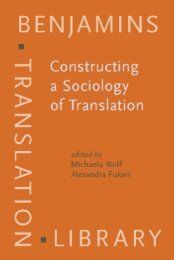Translation Theories.pdf
Translation Theories.pdf
Translation Theories.pdf
Create successful ePaper yourself
Turn your PDF publications into a flip-book with our unique Google optimized e-Paper software.
Meaning: A translator's view of how the concept of meaning could be<br />
best conceived and defined for the trade<br />
This paper has been encouraged by the publication of Maite Aragonés Lumeras:<br />
Meaning: The Philosopher’s Stone of the Alchemist Translator (<strong>Translation</strong> Journal,<br />
Volume 12, No. 3 July 2008 http://translationjournal.net/journal/45meaning.htm). She<br />
seems to be brave enough to raise the issue of the definition of meaning in a context<br />
where even theoretical and applied linguists fail to provide a decent definition of the<br />
term. For instance, a prominent professor of Linguistics in Hungary 1 has only this to say:<br />
„meaning (sense) is a relational term...". Whereas the term itself „relational" never gets<br />
defined elsewhere, and I am not surprised.<br />
But I am pleasantly surprised at reading Lumeras's statement that in some areas of<br />
study the importance of contextualizing texts is recognized, and „meaning is not content<br />
any more, but is relativized, negotiated and remodeled according to external factors...<br />
etc."<br />
We do not translate a<br />
word, but the longest sequence<br />
or cluster of words that makes<br />
sense when checked against<br />
two realities, in L1 and L2.<br />
I totally agree with her in defining meaning as a twopart<br />
entity (on each side of an equation formula): first as a<br />
phrase as written down or said, and second, as the context<br />
(taken in its widest sense) of reality sufficiently detailed to<br />
identify whatever is referenced or unambiguously defined<br />
by that phrase. Obviously, the less you know, the more<br />
explicit (additional written or oral) references you have to be given of anything to be<br />
identified or described, and vice versa, always keeping in mind that you are helped to<br />
grasp the meaning as far as it is complemented by the availability of a or the context. Man<br />
is a meaning-seeking animal, so he will also seek meaning where meaning is not obvious<br />
or is hidden, allowing that meaning is not a property of texts only. Meaning is something<br />
more general; it can be attributed to natural phenomena, pictures, sounds and anything<br />
that may have relevance to the human condition and intentions. Hence the provision of a<br />
definition of meaning is not the privilege of linguistics, but should be a shared product of<br />
psychologists, philosophers and other scholars to name just a few. Recently, ICT and AI<br />
scientists (including ontologists) have had a good say about the possible and widely<br />
acceptable variations of meaning, which should also be considered and tried. Ontologists<br />
are engaged in defining the meaning of various knowledge domains and they produce<br />
what they call semantic nets, various repertories of concepts with some graphic<br />
representations of the relations between them.<br />
Yet the most common repertory of meaning limited to that of a word only is<br />
usually a dictionary of some kind. I am not going to evaluate dictionaries here; I will only<br />
risk one important remark: the fact that the core of most dictionaries is a headword is a<br />
serious drawback to the further development of knowledge in linguistics and translation<br />
technology. The association between one word and a string of other words taken as<br />
The <strong>Translation</strong> <strong>Theories</strong>: From History to Procedures<br />
Edited by Zainurrahman<br />
Source: Personal Journal of Philosophy of Language and Education<br />
(http://zainurrahmans.wordpress.com) 85

















